Boron content in different plant parts of soybean as influenced by boron application
Bạn đang xem bản rút gọn của tài liệu. Xem và tải ngay bản đầy đủ của tài liệu tại đây (283.15 KB, 9 trang )
Int.J.Curr.Microbiol.App.Sci (2020) 9(3): 1286-1294
International Journal of Current Microbiology and Applied Sciences
ISSN: 2319-7706 Volume 9 Number 3 (2020)
Journal homepage:
Original Research Article
/>
Boron Content in Different Plant Parts of Soybean as
Influenced by Boron Application
Aditi Chourasia*, H. K. Rai, Jayhind Prajapati and Arpit Suryawanshi
Department of Soil Science and Agricultural Chemistry, JNKVV, Jabalpur, 482004, India
*Corresponding author
ABSTRACT
Keywords
Partitioning,
Boron,
Periodicity
Article Info
Accepted:
05 February 2020
Available Online:
10 March 2020
The investigation entitled “Boron content in different plant parts of Soybean as
influenced by Boron application” was carried out during Kharif season (2016)
on Soybean variety JS-97-52 to study the partitioning of boron in soybean as
affected by periodicity and levels of boron application. Field experiment
carried out at Research Farm, JNKVV, Jabalpur with soybean variety JS 9752 was laid in split plot design with three main treatments of periodicity
(single year, alternate year and each of year B application) and five sub
treatments of levels of Boron application (0, 0.5, 1.0, 1.5 and 2.0 kg B ha -1)
along with recommended dose of NPK. Treatments were replicated thrice
under optimum agronomic management practices. Boron content in leaf, stem
and root at different days interval was significantly affected by Boron
application and found maximum under 2.0 kg B ha-1 treatment. Significant
change in content of Boron in pod, seed and stover due to Boron application
was found with the highest content under 2.0 kg B ha -1 treatment which was at
par with that under 1.5 kg B ha-1 treatment while the interaction effects were
found non significant.
Introduction
Balanced and optimal use of inputs, especially
nutrients, is the key for agricultural
production system. In spite of balanced
application of macronutrients, productivity
and quality of soybean has been diminishing
mainly due to spreading of micronutrients
deficiency as a result of intensive cropping,
loss of top soil through erosion, loss of
micronutrients by leaching and reduction in
use of organic sources of plant nutrients.
Micronutrients are usually required in minute
quantities, nevertheless are vital to plant
growth as they improve general condition of
plant and are known to act as catalysts in
promoting bio-chemical reactions taking
place
in
plant.
Among
different
micronutrients boron is one of the essential
elements and belongs to the metalloid group
1286
Int.J.Curr.Microbiol.App.Sci (2020) 9(3): 1286-1294
of element with intermediate properties
between metals and non-metals. In several
plant functions, B is implicated directly and
indirectly as it involves in cells growth in
newly emerging shoot and root. It is also
crucial for pod formation, flowering,
pollination, seed development, transport of
sugar synthesized by different plant
components (Miwa et al., 2008) and synthesis
of amino acids and root nodulation
(Yamagishi and Yamamoto, 1994). Boron
deficiency at early growth stage significantly
boosts chlorophyll content in leaf, minimizes
carbohydrate transport from leaf to fruit and
ultimately leaf photosynthetic rate and
stomatal conductance is abated. Availability
of B in soil regulates the biomass
accumulation and partitioning in plant and
also influences the productivity of soybean.
The increase in plant biomass is also
associated by an increase in B concentration
in plant parts which is always higher in
reproductive than vegetative parts (Asad et. al
2002 and Goldberg et. al 2003).To assess the
content of Boron in different plant parts of
soybean the field experiment was conducted
to study the concentration of boron in
different plant parts i.e. partitioning of boron
in soybean as affected by periodicity and
levels of boron application.
Materials and Methods
The field experiment was conducted during
kharif season of 2016 at Research Farm,
Department of Soil science and Agricultural
Chemistry, JNKVV, Jabalpur (MP). The soil
of the experimental site was Vertisol
belonging
to
fine
Montmorillonite,
Hypothermic family of Typic Haplusterts
popularly known as “Black cotton soil”
having neutral soil reaction. The experiment
was laid out under the ongoing AICRP on
Micro, Secondary Nutrients and Pollutant
Elements in Soils and Plants during kharif
season of 2016. The experiment consists of 3
main treatments of periodicity of boron (B)
application and 5 sub treatments of B levels
which were and replicated 3 times in a Split
plot design. The details of treatments of
experiment are:
Main plot treatments: 3 (Periodicity of B
application)
P1: Single year (Once in 6 years)
P2 : Alternate year
P3 : Each year.
Sub plot treatments: 5 (Levels of B
application)
B0 : 0.0 kg B ha-1
B0.5 : 0.5 kg B ha-1
B1.0 : 1.0 kg B ha-1
B1.5 : 1.5 kg B ha-1
B2.0 : 2.0 kg B ha-1
To obtain the desirable seedbed for sowing
the field was ploughed once in summer with
disc plough followed by two cross harrowing
and a final harrowing followed by planking to
level the field. Good quality seeds of soybean
variety JS-9752 was used @ 80 kg ha-1 and
were placed in soil at 3-4 cm depth in rows
having spacing of 40 cm. Basal application of
recommended dose of N, P2O5 and K2O (20,
80 and 20 kg ha-1) was done in all the plots
before sowing through urea (46 %N), single
super phosphate (16%P2O5) and muriate of
potash (60%K2O) respectively and Boron was
applied through borax (10.6%B) according to
the treatment at the time of sowing as soil
application. During the crop growth period a
manual thinning was done at 15 days after
sowing to maintain the optimum plant
population and two manual hand weeding at
15 DAS and 45 DAS were done in order to
remove the weeds. The crop was harvested
after maturity when 90% leaves become
yellow and grain become hard.
Three randomly selected plants form each
plot were sampled at 30, 45, 60 and 90 DAS,
1287
Int.J.Curr.Microbiol.App.Sci (2020) 9(3): 1286-1294
and at harvest of the crop and brought to the
laboratory for the determination of boron
content in different plant parts (B
partitioning) of soybean. In the laboratory,
collected samples were washed under tap
water for 2 to 3 times to remove the foreign
impurities and adhering soil particles over the
plant surface if any. After that plant samples
were washed with the 0.1 N HCl carefully.
After precise washing the plant parts (leaf,
stem, root from the collar region and pod)
were separated and oven dried at 60 0C till the
constant dry weight obtained. After proper
drying, leaf, stem, root and pod samples were
grind separately. After processing of plant
samples Boron content in plant samples was
determined
spectrophotomatrically
by
Azomethine H method as described by Berger
and Truog (1939). The data obtained during
estimation of Boron content in plant was
statistically analyzed by the method of
analysis of variance technique (Panse and
Sukhatme, 1967).
Results and Discussion
The concentration of boron in different plant
parts of soyabean estimated during the
experiment
showed
its
maximum
concentration in leaves followed by stem and
minimum in root till the vegetative phase.
Higher concentration of B in leaf may be
attributed to role of B as one of the important
structural components for cell wall and
passive movement of boron within the plant
along with the transpiration stream. While,
higher B concentration in stem as compared
to roots might be supported by the reason that
B involves in various meristematic activities.
Further it was also found that concentration of
boron in reproductive plant part was higher
than vegetative part which might be because
of translocation of B from leaves and other
vegetative parts towards the reproductive part.
Marentes et al., (1997) also reported that B
was transported through the phloem, as
phloem transport is independent of
transpiration and supplies the major
proportion of nutrient requirements for
actively growing organs, such as young
leaves, pods, and seeds.
Temporal variation in boron concentration in
different parts (leaf, stem, root, pod, seed and
stover) of soybean was estimated to find out
the boron partitioning behaviour in plant and
the results thus obtained are presented in
under the following sub-heads:
Boron concentration in leaf
Data pertaining to the boron concentration in
leaf as affected by periodicity and levels of
boron at 30, 45, 60 and 90 days after sowing
(DAS) presented in table 1.1 clearly indicates
that boron concentration in leaf increased due
to periodicity of boron application from single
year to each year but difference was found
statistically non- significant. It is also evident
that maximum concentration (25.87, 28.67,
29.06 and 29.75 mg kg-1) of B in leaf at 30,
45, 60 and 90 DAS, respectively was obtained
in each year B application treatment followed
by alternate and single year B application
treatments. The data further showed that the
increasing levels of boron application
progressively increased it’s concentration in
leaves at all the intervals of crop growth
under study and highest B concentration in
leaf was obtained with the application of 2.0
kg B ha-1(26.76, 29.65, 30.53, 30.27 mg kg-1
at 30, 45, 60 and 90 DAS, respectively) which
was significantly higher than control but
statistically at par with other treatments of B
levels.
This finding was in good agreement with
those reported by Moreira et al., (2011) and
Reinbott et al., (1997). Concentration of B in
leaf increased up to 60 DAS and thereafter
decreased till 90 DAS which may be
attributed
to
increased
dry
matter
1288
Int.J.Curr.Microbiol.App.Sci (2020) 9(3): 1286-1294
accumulation from 60 DAS to 90 DAS but
decreased uptake of B in plant.
Boron concentration in stem
The concentration of boron in stem at 30, 45,
60 and 90 DAS as affected by periodicity and
levels of B application in soybean presented
in table 1.2 clearly indicated highest
concentration of boron in stem (14.37, 17.06,
18.89, 18.17 mg kg-1 respectively) in each
year B application treatment followed by
alternate and single year B application. At 30
and 60 DAS the effect of periodicity on boron
concentration in stem was found nonsignificant but at 45 and 90 DAS
concentration of B in stem under each year
application treatment was significantly higher
than single year and at par with alternate year
application of boron. The data further
indicated B concentration in stem increased
with increasing level of boron at various
intervals under study. However, significant
higher B concentration in stem over control
was found in 1.5 and 2.0 kg B ha-1 application
treatments but the difference in B
concentration in stem between these two
treatments was statistically at par.
These findings are well supported by those
reported by Choi et al., (2015) which also
stated that increasing levels of boron
application significantly increased the boron
concentration in stem of the plant.
Boron concentration in root
Effect of periodicity and levels of boron
application on B concentration in root was
also studied at 30, 45, 60 and 90 DAS and
data given in table 1.3 revealed that the boron
concentration in root of soybean increased up
to 45 DAS and then further decreases. At 30,
60 and 90 DAS the concentration of B in root
of soybean in each year B application
treatment was significantly higher than single
year B application but statistically at par with
alternate year. But at 45 DAS concentration
of B in root under alternate and each year B
application treatments was significantly
higher than single year B application
treatment. Data further revealed that
increasing levels of boron application
increased the B concentration in roots at
different DAS. Boron concentration in root at
30 DAS was significantly higher under 1.0,
1.5 and 2.0 kg B ha-1 treatments as compared
to control but the difference in B
concentration in root under 1.5 and 2.0 kg ha-1
B application was statistically at par.
However, at 45, 60 and 90 DAS the
concentration of boron in root under 1.5 and
2.0 kg B ha-1 treatments was significantly
higher than control but statistically at par in
both.
Maximum B concentration in root at 45 DAS
and then its decreased concentration till 90
DAS might be attributed to highest root
nodulation at 45 DAS that decreased
afterward and B is directly involved in the
development of root nodules. Also it might be
due to translocation of boron from root
towards reproductive parts of the plant as
after 45 DAS the reproductive stage of
soybean crop started and accumulation of B in
root was decreased and root biomass
increased that resulted in lower concentration
due to dilution factor. Similarly, Yamagishi
and Yamamoto (1994) also found that B
deficiency resulted in underdeveloped
nodules in soybean. Reduction in boron
content in root towards reproductive phase
was also found by Zhang et al., (2012) which
closely support the findings of the present
investigation.
Boron concentration in pod
Data pertaining to the concentration of boron
in pod of soybean as affected by periodicity
and increasing B levels at 60 and 90 DAS are
1289
Int.J.Curr.Microbiol.App.Sci (2020) 9(3): 1286-1294
presented in table 1.4. The data revealed that
the periodicity of boron application had a
significant effect on B concentration in pod of
soybean. Data also showed that B
concentration in pod at 60 and 90 DAS under
each and alternate year B application
treatments was statistically at par but
significantly higher than single year B
application. The data further revealed that B
concentration in pod increased with
increasing B application in soybean and
highest concentration (32.74 and 35.09 mg
kg-1) was obtained at 60 and 90 DAS,
respectively under 2.0 kg B ha-1 application
treatment. At 60 DAS the concentration of B
in pods was significantly higher under 1.5 and
2.0 kg B ha-1 application treatments as
compared to control, while at 90 DAS under
1.0, 1.5 and 2.0 kg B ha-1 treatments it was
found significantly higher than control. But
the B concentration in pod under 1.5 and 2.0
kg B ha-1 application treatments was found
statistically at par.
The significant increase in concentration of B
in pods of soybean increased due to
periodicity and increasing levels of B
application were well supported by the
finding of Moreira et al., (2011) and Rathod
et al., (2016) which also showed significantly
higher B concentration in pod, seed and
stover due to higher level of boron either as
soil or foliar applied B through soil and foliar
application.
Boron concentration in seed and stover
It is clearly evident from the data given in
table 1.5 that a significant effect of periodicity
and levels of boron application on boron
concentration in seed and straw of soybean
was observed with a significantly high
concentration of B in seed under alternate
(32.93 mg kg-1) and each year (34.29 mg kg-1)
as compared to single year (30.04 mg kg-1) B
application treatment, but statistically
alternate and each year B application
treatments were at par.
Table.1 Effect of periodicity and levels of boron application on boron concentration in leaves of
soybean
Treatment
Periodicity of B application
Single Year
Alternate Year
Each Year
SEm ±
CD(p=0.05)
Levels of B application (kg ha-1)
B0
B0.5
B1.0
B1.5
B2.0
SEm±
CD(p=0.05)
Boron concentration in leaf (mg kg-1)
30 DAS
45 DAS
60 DAS
90 DAS
24.77
25.05
25.87
0.60
2.34
27.55
28.01
28.67
0.44
1.73
28.57
29.05
29.06
0.77
3.03
27.05
29.26
29.75
0.84
3.31
23.45
24.22
25.57
26.05
26.76
0.92
2.63
26.88
27.66
27.80
28.41
29.65
0.89
2.55
27.81
28.03
28.85
29.27
30.53
0.84
2.41
27.71
27.96
28.48
29.02
30.27
0.88
2.53
1290
Int.J.Curr.Microbiol.App.Sci (2020) 9(3): 1286-1294
Table.2 Effect of periodicity and levels of boron application on boron concentration
in stem of soybean
Treatment
Periodicity of B application
Single Year
Alternate Year
Each Year
SEm ±
CD(p=0.05)
Levels of B application (kg ha-1)
B0
B0.5
B1.0
B1.5
B2.0
SEm±
CD(p=0.05)
Boron concentration in stem (mg ka-1)
30 DAS
45 DAS
60 DAS
90 DAS
12.98
13.81
14.37
0.39
1.54
14.13
16.73
17.06
0.64
2.50
17.07
18.03
18.89
0.65
2.55
16.74
17.74
18.17
0.35
1.37
12.31
13.27
13.68
14.36
14.98
0.52
1.48
14.47
15.27
15.87
16.57
17.68
0.57
1.62
16.56
17.20
17.87
18.98
19.36
0.54
1.54
16.06
17.07
17.23
18.13
19.27
0.65
1.87
Table.3 Effect of periodicity and levels of boron application on boron concentration in roots of
soybean
Treatment
Periodicity of B application
Single Year
Alternate Year
Each Year
SEm ±
CD(p=0.05)
Levels of B application (kg ha-1)
B0
B0.5
B1.0
B1.5
B2.0
SEm±
CD(p=0.05)
Boron concentration in root (mg kg-1)
30 DAS
45 DAS 60 DAS
90 DAS
12.47
12.89
13.93
0.29
1.12
14.68
15.53
16.00
0.17
0.66
13.47
14.51
15.76
0.42
1.64
13.14
14.07
15.20
0.28
1.09
10.91
12.61
13.19
13.97
14.80
0.69
1.96
14.40
14.75
15.45
15.99
16.42
0.49
1.40
13.49
13.94
14.45
15.04
15.97
0.51
1.46
13.08
13.62
14.00
14.44
15.56
0.43
1.23
1291
Int.J.Curr.Microbiol.App.Sci (2020) 9(3): 1286-1294
Table.4 Effect of periodicity and levels of boron application on B concentration in pod
Treatment
Boron concentration in pod (mg kg-1)
60 DAS
90 DAS
Periodicity of B application
Single Year
Alternate Year
Each Year
SEm ±
CD(p=0.05)
Levels of B application (kg ha-1)
B0
B0.5
B1.0
B1.5
B2.0
SEm±
CD(p=0.05)
28.24
29.87
31.01
0.364
1.430
29.06
31.73
33.15
0.618
2.429
27.00
28.03
29.29
31.46
32.74
0.877
2.505
28.46
30.22
31.00
32.81
34.09
0.682
1.948
Table.5 Effect of periodicity and levels of boron application on B concentration
in seeds and stover of soybean
Boron concentration (mg kg-1)
Seeds
Stover
Treatment
Periodicity of B application
Single Year
Alternate Year
Each Year
SEm ±
CD(p=0.05)
Levels of B application (kg ha-1)
B0
B0.5
B1.0
B1.5
B2.0
SEm±
CD(p=0.05)
1292
30.04
32.93
34.29
0.295
1.159
26.81
28.41
29.57
0.473
1.860
29.31
31.08
32.07
34.47
35.16
0.806
2.303
24.81
27.25
28.08
29.56
31.63
0.875
2.498
Int.J.Curr.Microbiol.App.Sci (2020) 9(3): 1286-1294
Figure.1 Effect of levels of boron application on partitioning of boron in soybean
However, the concentration of B in straw
under each year B application (29.57 mg kg-1)
was significantly higher than single year
application (26.81 mg kg-1) and statistically at
par with alternate year B application (28.41
mg kg-1) treatment.
Data further indicated that B concentration of
seeds in control (29.31 mg kg -1) was found
significantly lower than 32.07, 34.47 and
35.16 mg kg-1 recorded under the treatments
of boron levels of 1.0, 1.5 and 2.0 kg B ha-1,
respectively. Similarly, the B concentration
(28.08, 29.56 and 31.63 mg kg-1) in straw
under the application of 1.0, 1.5 and 2.0 kg B
ha-1 treatments, respectively was found
significantly higher than control (24.81 mg
kg-1). Data also revealed that concentration of
B in seeds and straw of soybean under 1.5 and
2.0 kg B ha-1 application treatments was
found statistically at par. The results are
closely supported by the findings of Eguchi
(2000) and Rathod et al., (2016) which stated
that B content in seed and straw increased
with increasing levels of boron application.
It is concluded from the data that application
of Boron as a nutrient source to Soybean crop
significantly influence its concentration in
leaf, stem, root, pod, seed as well as in stover
also. It was found maximum under the
application of 2.0 kg B ha-1 which was
statistically at par with that found in 1.5 kg B
ha-1 treatment and minimum was reported in
control. Among the different plant parts of
soybean maximum content of Boron was
reported in leaves during vegetative stage
while during reproductive stage pods were
having the maximum content and at harvest
seeds are reported with the maximum and
roots were having the minimum Boron
content.
Acknowledgement
All the authors are very much thankful to
ICAR-AICRP on Micro and Secondary
Nutrients and Pollutant Elements in Soils and
Plants and College of Agriculture JNKVV,
Jabalpur for providing all the necessary
facilities during the work.
References
Asad A, Blamey FPC, Edwards DG. 2002.
Dry matter production and boron
concentrations of vegetative and
reproductive tissues of canola and
1293
Int.J.Curr.Microbiol.App.Sci (2020) 9(3): 1286-1294
sunflower plants grown in nutrient
solution. Plant and Soil. 243: 243–252.
Berger KC and Truog E.1939. Boron
determination in soils and plants. Ind.
Eng. Chem. Anal. Ed. 11:540-545.
Choi EY, Park H, Ju JH and Yoon YH. 2015.
Boron availability alters its distribution
in plant parts of tomato. Horticulture,
Environment
and
Biotechnology.
56:2,145–151.
Eguchi S. 2000. Effect of boron deficiency on
growth, yield and contents of protein
and fat in seeds of soybeans
(Glycine max). Japanese Journal of Soil
Sci. and Plant Nutrition.71(2): 171-178.
Goldberg S, Shouse PJ, Lesch SM, Grieve
CM, Poss JA, Forster HS and Suarez
DL. 2003. Effect of high boron
application on boron content and
growth of melons. Plant and Soil. 256:
403–411.
Marentes E, Shelp BJ, Vanderpool RA and
Spiers GA. 1997. Retranslocation of
boron in broccoli and lupin during early
reproductive growth. Physiol. Plant.
100, 389–399.
Miwa K, Takano J and Fujiwara T. 2008.
Molecular mechanisms of boron
transport in plants and its modification
for
plant
growth
improvement.
Tanpakushitsu kakusan koso, Protein,
Nucleic acid, Enzyme. 53(9): 11731179.
Moreira A, Castro C and Fageria NK. 2011.
Effects of Boron application on yield,
foliar Boron concentration, and
efficiency of Soil Boron extracting
solutions in a Xanthic Ferralsol
Cultivated with Banana in Central
Amazon. Communications in Soil
Science and Plant Analysis. 42: 2169–
2178.
Panse VG and Sukhatme PV. 1967. Statistical
Method for Agricultural workers. ICAR
New Delhi. pp 97-151.
Rathod PK, Salvi VG, Pawarand SS and
Chavan KN. 2016. Effect of lime, zinc
and boron on yield and uptake of
micronutrients by soybean. An Asian
Journal of Soil Science. 11(2), 290-296.
Reinbott TM, Blevins DG and Schon MK.
1997. Content of boron and other
elements in main stem and branch
leaves and seed of soybean. Journal of
Plant Nutrition. 20:7-8, 831-843.
Yamagishi M. and Yamamoto Y. 1994.
Effects of boron on nodule development
and symbiotic nitrogen fixation in
soybean plants. Soil Sci. and Plant
Nutrition. 40:2, 265-274.
Zhang J, Wei C, Wang X, Wang J, Zhu Q,
Meining LI. 2012.Effect of Boron
Foliar Application on the Absorption
and Distribution of Boron in the Soil
with Different B Levels and S on
Cotton Yield. Journal of Shihezi
University (Natural Science).
How to cite this article:
Aditi Chourasia, H. K. Rai, Jayhind Prajapati and Arpit Suryawanshi. 2020. Boron Content in
Different Plant Parts of Soybean as Influenced by Boron Application.
Int.J.Curr.Microbiol.App.Sci. 9(03): 1286-1294. doi: />
1294

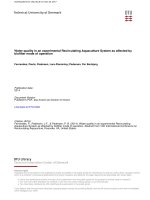
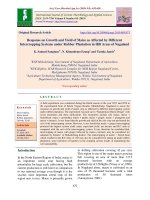

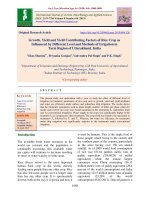

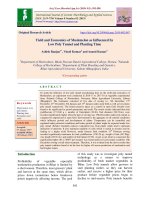
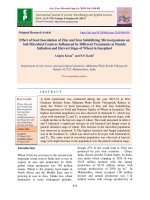

![Growth and yield of Ashwagandha [Withania somnifera (L.)] as influenced by different intercropping system in Kymore plateau of Madhya Pradesh](https://media.store123doc.com/images/document/2020_01/09/medium_vsb1578562778.jpg)